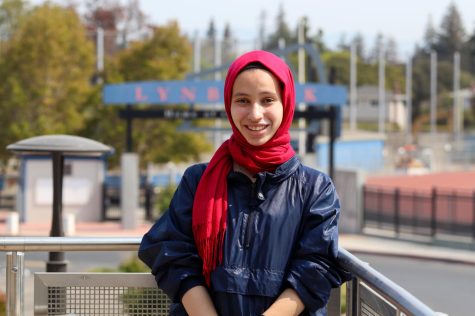Taking a look at Lynbrook’s Asian history
Graphic Illustration by Lina Mezerreg
A viking helmet picturing the continents of North America and Asia, symbolizing the diversity and history of Lynbrook’s Asian history
May 26, 2021
It is no secret that Lynbrook is an Asian-majority campus. 84% of all Lynbrook students are of Asian descent, and the second-highest racial group are Caucasians, who make up just over 7% of the population. However, this phenomenon is not exclusive to Lynbrook. In fact, three out of the five schools in FUHSD have student bodies that are at least 72% Asian. How, then, did Lynbrook become this way?
Some point to the overwhelming number of Asians who have immigrated to the area since the 1890s. Before Santa Clara County became the Silicon Valley of today, it was known as The Valley of Heart’s Delight, featuring an economy based on exportation of fruit and other agricultural products. Since the 1890s, Chinese, Japanese and Filipino immigrants working as migrant farm laborers have become an integral part of the region’s economy.
Chinese-Americans drawn by the area’s technology boom began immigrating to Cupertino in the 1970s and 80s, and they quickly established the roots of the Asian-American community seen today. South Asians soon followed suit, primarily immigrating to the area due to the job opportunities created by the dot-com boom in the early 2000s.
“If you look at the early Lynbrook yearbooks, what you’re going to see is, of the Asians that are in the school at the time, a lot of them have surnames that indicate a Japanese ancestry,” social studies teacher and Lynbrook alum Jeffrey Bale said. “These are the families that have already been California residents for two, three generations. And what’s fascinating is that as you go through the years of the yearbook, you start to see different demographic groups that migrated here — first the Chinese-Americans, and then later on first-generation Korean and Indian immigrants.”
Thus, Cupertino became known as a magnet community among demographers, attracting Asian immigrants because of its ability to replicate the environment of their home countries. Tin Tin Supermarket, the first Asian supermarket in Cupertino, opened its doors in the mid-1980s. Soon after, other major marketplaces such as Marina Foods and Ranch 99 took up residence in the community as well. Nowadays, Asian-American grocers line the main streets of the city, with many Asian bakeries and restaurants opening alongside them.
On top of the growth of new Asian businesses, the area also saw a rise in Asian-American financial institutions, like banks, that specifically catered to new immigrants. The opening of these establishments made Cupertino a city where financial planning was easier for those new to the American banking system. This increased access to financial planning meant that immigrants could begin to build community wealth faster, further incentivizing them to settle in the area.
Asian-Americans were also motivated to move to Cupertino due to the academic strength of schools. In the 1970s, young Chinese-American tech workers preferred to live in newer neighborhoods like Berryessa in San Jose. As these workers grew older and started families, however, they began to prefer areas with better schools. As such, FUHSD schools, which had a reputation for academic excellence, began observing an uptick in Asian-American students in the 1990s.
This desire for children to attend competitive schools is also the reason for the similar demographic makeup seen today in Alameda County schools, such as Mission San Jose and Irvington High, which consistently rank in the top 50 schools of California. In fact, a case study done by Loyola Marymount professors Wei Li and Edward Park in 2006 discovered that certain Bay Area area zip codes were well-known even among certain circles in Taiwan, China and Korea due to the quality of education offered at these schools.
“Immigrants from Taiwan, South Korea, Mainland China and India would join this influx of the world’s greatest concentration of business and engineering talent in the Bay Area,” Park said. “Cupertino, in particular, is at the center of this amazing intersection of talent. One of the complexities of this concentration of achievement and talent is the academic pressure on schools and students in places like Cupertino.”
The racial disparity specific to the Lynbrook area has been further fueled by the recent departure of white families. Concerns about academic pressure at Lynbrook and other Asian-majority schools in the area, such as Monta Vista and Cupertino High, have caused some families to move out or avoid the area altogether when shopping for homes.
Some have taken to calling this recent phenomenon a second wave of white flight, a term coined in the 1950s to describe the mass exodus of upper-class whites from the cities into affluent suburbs. Now, instead of moving to suburbs, white families are moving to other school districts, citing intense academic environments as the reason behind their departure. Some blame the academic pressure on the Asian-American parents of the school, who allegedly place an extreme emphasis on performing well in school. In fact, in 2005, the Monta Vista parent teacher association even went as far to dissuade a white family from moving to Cupertino due to the small number of white students left in the schools.
“I do think that there are worried parents — regardless of race — who feel that important elements of American educational experiences are lost when the emphasis of a school becomes too narrowly focused on academic achievement,” Park said. “I do see some parents who are also weary that academic focus is depriving students of extra-curricular and social activities that have been such an important part of the American educational experience.”
Another factor arises from the Lynbrook community itself: A sizable portion of the community is wary of letting students from outside the community into the school. In 2016, the FUHSD board gave serious consideration to expanding Lynbrook’s enrollment boundaries to include the John Mise neighborhood, an area that primarily feeds into Cupertino High School. Some Lynbrook parents vehemently opposed this proposal out of fear of a drop in the quality of the education and a drastic increase in competition, among other concerns. Due to the heavy backlash from parents, the FUHSD board opted to continue using its open enrollment lottery technique — which utilizes a randomized name selection system to choose prospective students from outside Lynbrook’s boundaries — for the 2017-18 school year, which temporarily alleviated the problem.
A driving force behind Lynbrook parent concerns about the school’s ranking lies in the direct tie between the school’s prestige and the value of property in the surrounding areas. Many speculate that Lynbrook parents oppose expanding the school’s boundaries to keep property prices in the area high. This has made the primarily Asian-American Lynbrook community increasingly isolated, in part because of the transient nature of the Asian-Americans that do live there, but also due to the exorbitant housing prices in the area today. As a result, some families, including those with ancestral roots in the area, are simply priced out of the neighborhoods and the opportunities that come with living in them.
“The Lynbrook community is incredibly transient,” Bale said. “People will move in, they will live here while their kid is here, and then they’ll move away. This isn’t inherently bad, but it does give Lynbrook a weaker sense of community than other schools where families stay in the area for 30, 40 years.”
Lynbrook’s Asian-American community is not going away anytime soon. With housing prices on a steady incline and a growing, tightly-knit and insular community, elements of the Asian-American community will likely continue to dominate the area’s streets — and Lynbrook’s halls — for years to come.





































































Will • Jul 31, 2021 at 5:40 pm
The title of this article is Lynbrook’s asian history, but it mainly talks about what happened in Cupertino.
No asian student or parent in the Lynbrook area is mentioned or interviewed in this article.
This article tries to paint “while fight” as a politically correct thing, instead of as a bias, and try to stereotype asian Americans.
Nick • Sep 15, 2022 at 8:36 am
All the stereotypes the article mentions are true. It doesn’t interview anyone, white, Asian, or other. If I had kids, I would move away too. I appreciate diversity, and at Lynbrook there’s not enough of it when 90% of the students are Asian, and every parent is a stereotype of the narrow-minded, overly focused on academia type.